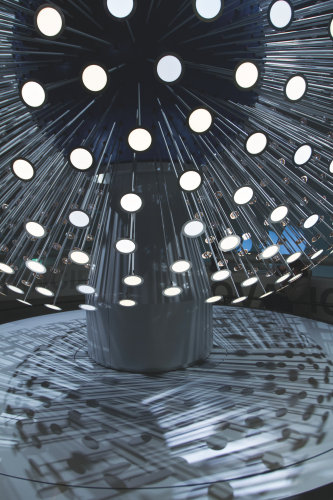OLYMP project aims to make OLED as efficient as LED

The main aims of the common project are to improve the efficiency and service life of organic light emitting diodes (OLEDs). In addition, production costs have to be minimised to ensure that OLEDs can be successful in the general lighting mass market. In the past years, the participating companies have achieved innovative advantages that are intended to be expanded as a part of the funded project.
With OLYMP (Organic Light emitting sYstems based on energy and cost-efficient Materials and Processes), the Federal Ministry for Education and Research is supporting an association of German companies that have achieved leading positions in the sector and aim to bring OLED technology to market maturity for the volume market. "We want to offer customers OLEDs that have superior energy efficiency compared to traditional light sources," said Ulrich Eisele, head of the OLED sector at Osram. Research is being specifically carried out to achieve efficiency values greater than 100 lm/W and to increase operational lifetimes. OLED, in the mid-term, should become as efficient as related LED technology and in the long term OLED should also be pliable and as transparent as glass panels.
The successes of past funded projects, combined with intensive research, have brought OLED technology to a level that enables OLED panels to be integrated into high quality designer luminaires. Current OLED panels however are too expensive for a wider spectrum of use, for example as part of general lighting. Manufacturing costs intended to be reduced by new forms of materials among other factors are essential conditions that dictate prices.
From concept to luminaire
The association of companies follows a complete approach that covers all value creation levels, from organic materials that enable an OLED to illuminate, OLED panels to finished luminaires. The technological advantage achieved by participating companies is also intended to be maintained and expanded upon. OSRAM GmbH is formulating concepts for increased efficiency of OLED panels. Its subsidiary, Osram Opto Semiconductors, is project coordinator and benefits from wide expertise in the field of OLED manufacture. Organic functional materials have been developed by Merck KGaA. Base-lampholder concepts are being researched by BJB GmbH & Co.KG, and LEDON OLED Lighting GmbH & Co. KG is developing high-integration modules in which OLEDs panels are equipped with driver electronics. Trilux GmbH & Co. KG is responsible for the development of new OLED-based luminaires. The funded project is running until 1 September 2015 and has a total value of 34 million euros.
OLED – light in its most modern form
OLEDs, as with LEDs, are semiconductors that convert electric current to light. While LEDs emit point light from a tiny luminous chip, OLED panels are luminous surfaces produced by vaporizing various organic plastics onto a substrate material. The luminous layer of an OLED is around 400 nanometres thick, corresponding to one hundredth of a human hair. OLEDs, according to base material, appear reflective, neutral white or transparent in switched-off state.
ABOUT OSRAM
OSRAM of Munich, Germany is one of the two leading light manufacturers in the world. The company's portfolio covers the entire value chain from components – including lamps, opto semiconductors like light-emitting diodes (LED) – to electronic control gears as well as complete luminaires, light management systems and lighting solutions. OSRAM has around 39,000 employees worldwide and generated revenue of 5.4 billion Euros in fiscal year 2012 (ended September 30, 2012). More than 70 percent of its revenue comes from energy-efficient products. The company's business activities have been focusing on light – and hence on quality of life – for over 100 years. Additional information can be found in the internet at www.osram-group.com